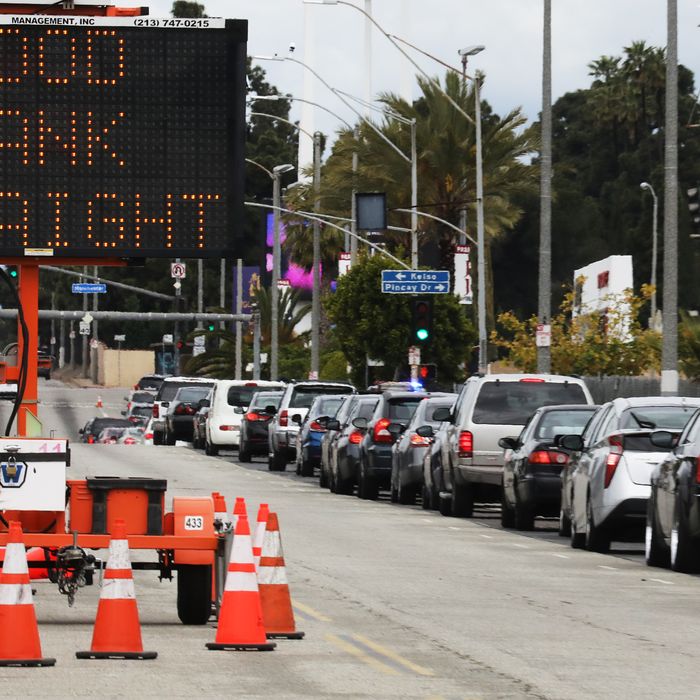
Two of the enduring images of COVID-19’s economic impact contradict each other: As miles-long lines back up at food banks throughout the country, millions of tons of ripe fruits and vegetables are being buried in their fields, with farmers losing out on half of their usual markets with restaurants, schools, and hotels closed. Though the apparent simplicity of solving one crisis with the other — providing the food insecure with unsellable product, rather than dumping milk into manure pits — is frustrated by practical issues, the Department of Agriculture only emerged with a solution on April 17.
The USDA’s Coronavirus Food Assistance Program allocates $16 billion in direct aid to industrial farmers to offset losses, while outright purchasing $3 billion worth of fresh produce, dairy, and meat. The program will buy $100 million per month (each) of produce, dairy, and meat to “provide a pre-approved box of fresh produce, dairy, and meat products to food banks, community and faith based organizations, and other non-profits serving Americans in need.”
But according to farmers and industry experts who spoke with Politico, the CFAP is a woefully inadequate response to both the oversupply of unpurchased produce and the demand for food from the millions of Americans whose work has been impacted by the pandemic. Even a week into the crisis, produce groups informed the USDA that $1 billion was already “sitting stagnant in the supply chain,” suggesting that the $300 million-per-month figure is too low from the start. In California alone, the produce industry is projected to lose over $1 billion per month.
Federal officials who spoke with Politico also stated that there will be a delay of up to a month before farmers can expect government purchases, meaning that growers whose season peaked in March will miss out on the stimulus. “By the time that comes through, it won’t help Florida,” farmer Brittany Lee, head of the Florida Blueberry Growers Association, told Politico. With the closing of the hospitality industry, produce growers have been hit especially hard: Though food service represents around a quarter of the total food consumed in the U.S., 40 percent of the country’s fresh fruits and vegetables are consumed at restaurants.
While the food box program appears to connect supply to demand in theory , Tony DiMare, a food distributor with over 40 years in the field, told Politico of the plan’s many flaws:
“This thing is a joke,” said DiMare, who listened to the USDA’s recent briefing on the purchase program. He appreciates the department’s intentions, he said, but quickly counts off the program’s deficiencies: It’s not clear how many companies are set up to pack mixed varieties of produce into boxes. What happens to highly specialized growers? If a business only grows tomatoes, will it have to go find other vegetables for the box, or will everyone sell to a third party? Most painfully, the program simply won’t be up and running in time to help Florida, where the season is winding down.
It’s possible also that the Trump administration may be using the economic crisis to pursue pre-pandemic goals: Since February 2018, the White House has attempted to replace the Supplemental Nutrition Assistance Program — commonly known as food stamps — with “harvest boxes” full of shelf-stable items, arguing that it would save money, while ignoring the limitations it would have on consumer choice and the intake of fresh produce, already a luxury for millions of poor Americans living in food deserts.
The apparent shortsightedness of the USDA’s coronavirus plan is not the only White House response criticized for coming up short. While the initial tranche of funding for the Paycheck Protection Program (allowing small businesses to access up to $10 million in forgivable loans if at least 75 percent of the funds are put toward payroll) was depleted in 14 days, the additional $320 billion approved by the president last week could also run dry in days.
As the USDA finds a way to buy out farmers’ billion-dollar surpluses, there’s certainly no lack of demand: According to the food bank consortium Feeding America, charities have seen demand surge by 70 percent, while 40 percent of those requesting help are new to the system. Across the world — where 135 million faced acute food shortages before the pandemic — the United Nations estimates that an additional 130 million could face the threat of starvation by the end of the year.
"plan" - Google News
April 27, 2020 at 06:43AM
https://ift.tt/3ePMoDj
The USDA’s Plan to Feed Americans and Pay Farmers Is Not Enough - New York Magazine
"plan" - Google News
https://ift.tt/2un5VYV
Shoes Man Tutorial
Pos News Update
Meme Update
Korean Entertainment News
Japan News Update
Bagikan Berita Ini














0 Response to "The USDA’s Plan to Feed Americans and Pay Farmers Is Not Enough - New York Magazine"
Post a Comment